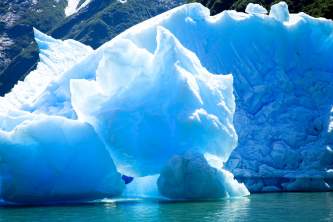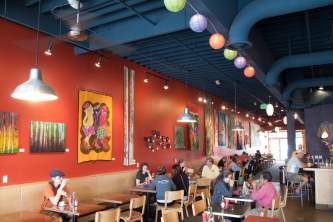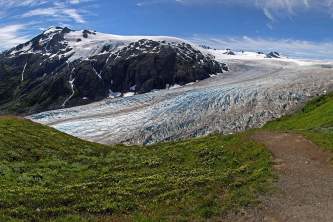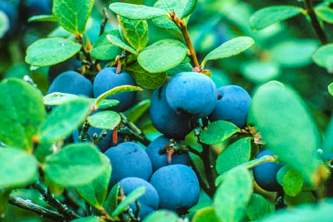Speak Alaskan
When you visit a new place, doesn’t it feel good to be taken as a local? In the case of Alaska, it’s a little harder. Our geographic isolation, cultural mix, and frontier lifestyles give rise to unique customs and words. To really be an insider, you’d need to move here for at least 5 years. Or you could just read the list below—and you’ll know more than 80% of residents.
Alaska Marine Highway System - This is another name for the state-owned ferry. It runs year-round and carries vehicles and passengers from Bellingham, WA to coastal towns throughout Southeast, Southcentral, Kodiak, and the Aleutians.
Alaska Permanent Fund Dividend Check - When oil was discovered in Prudhoe in the late seventies, so much money started to flow into the state treasury they didn’t know what to do with it. So they established the Permanent Fund, a “rainy day fund” which today has around $30 billion in assets. Each year, part of the earnings are distributed to residents in the form of a “PFD Check” or “dividend”. In recent years, checks have been in the $1500 range. Since Alaska has no state tax, the permanent fund could be thought of as a negative income tax—the state pays us to live here!
You’ll know it when the checks hit the streets in the fall by the outrageous number of “permanent fund specials” advertised for anything from airline tickets, to lazy boy rockers, to salon tanning sessions. Distributed to almost 500,000 Alaskans, it’s a half-billion dollar injection into the state economy that really makes a difference. Every year, there are political battles over whether the legislature should take more of the Fund’s earnings to pay for state government. But Alaskans love their PFD checks, and if I were a politician, I wouldn’t touch it!
Alaska Railroad - This state-owned railroad runs 470 miles from tidewater at Seward and Whittier north to Anchorage, Denali, and Fairbanks. There are only two feasible rail routes from tidewater into the Alaska’s Interior: the Alaska Railroad route and the route followed by the historic Copper River & Northwestern Railway up the Copper River Valley.
When the world’s largest copper deposit was discovered at Kennicott at the turn of the century, a wealthy eastern syndicate (Guggenheim, J.P Morgan) bought up the Copper River route. This occurred a time when the nation was waking up to the power of large trusts—and becoming alarmed. So the federal government stepped in, acquired the right-of-way for the current Alaska Railroad route, and started building the line in 1916. Construction headquarters were located at Ship Creek, giving rise to the town of Anchorage.
Alcan – Short for the Alaska-Canada Highway. The Alaska Highway was completed in 1942 as a military overland supply route and now runs 1,390 miles from Dawson Creek in Canada to Delta Junction, Alaska. Contrary to myth, 100% is paved today, although continual maintenance is required to keep up with frost heaves in the road. This section of the journey north takes 3-6 days of driving.
Alpenglow - A faint, orange-purple glow that paints snowy mountaintops at sunrise and sunset. Seeing alpenglow on the surrounding peaks is one of the rewards of winter skiing in the mountains.
Anchorage Fur Rendezvous (Fur Rondy) - A 4-day festival that occurs in mid-February which historically included dogsled races, fur auctions, and the Miners and Trappers Ball. In recent years, it seems they’re trying schedule it right before Iditarod so visitors can come up for both.
Arctic National Wildlife Refuge (ANWR) - A 19.5 million acre refuge east of Prudhoe Bay. ANWR is both the best prospect for a major onshore oilfield in the U.S. and the calving grounds for one of the last remaining big game migrations in the U.S. A majority of Alaska residents and oil companies want to see the 1.5 million acre coastal plain of ANWR opened for oil and gas exploration. Yet nationwide, a majority of Americans are opposed to lifting the current ban on exploration.
Aurora Borealis or Northern Lights – Colored bands of light in the sky are seriously cool to see. They're actually solar particles blown into the earth's magnetic field more than 60 miles above the earth's surface. Some people mistakenly think that the glow of city lights are northern lights, but the real thing starts as greenish bands that move in east-west direction, then sometimes evolve into undulating waves. They create greenish-yellow, faint blue, or even blood red curtains of color. Alaska Native groups once believed the lights had mystical powers, or were even the dancing spirits of the dead.
Baleen - Bony plates that hang from the jaw of baleen whales used to filter the seawater. Only Natives are allowed to harvest baleen. They use it in carvings, bracelets, or baskets which can cost thousands of dollars. Sometimes, you’ll see raw baleen for sale on street corners for around $50 per stalk.
Blanket Toss – An Inupiaq game that involves a circle of people holding the edges of a walrus hide that is used to toss one person into the air, kind of like a reverse trampoline. The origination of this game is hazy but one common belief is that whale and other game over the horizon could be spotted using this method.
Board of Game – The state board that oversees Alaska’s game resources. It is comprised of seven members that are directly appointed by the governor.
Borough - Instead of counties, Alaska is divided into 19 boroughs. Some are huge, such as the North Slope which is the size of Minnesota.
Breakup - Breakup signals springtime in Alaska. It’s the time of year when the frozen rivers break apart and flow again. In town, the snow melts, leaving enormous puddles, dirty cars, and generally quite a mess. It’s not a great time of year to travel in the backcountry because the snowpack is gone but the ground hasn’t dried out yet. (Also see freezeup.)
Bunny Boots – Originally developed for the army, these oversized rubber, insulated boots are a common sight when the deep freezes hit. You can get them in two colors; the traditional white Bunny Boot or the sleeker black version known as Mickey Mouse Boots. They’ll keep your feet warm down to the -70 degree F mark.
Bush - Refers to the large portion of Alaska that's not accessible by road. To reach villages in the bush you have to take alternative means of transportation such as airplanes or boats in the summer and snowmachines in the winter.
Cabin Fever – A mental state that sometimes comes about in response to Alaska’s long, dark winters and can be exacerbated by cold spells when residents are ‘cabin’ bound. The resulting behaviors range from irrational mutterings about ‘moving to Mexico’ to true depression.
Cache – Otherwise known as your insurance policy against wild animals, the cache is a small cabin-like structure elevated 8-15 feet off the ground for purposes of protecting ones food from hungry scavengers.
Cheechako - A very important word for visitors to know. A cheechako is a newcomer to the country. The name is usually used in the pejorative sense, such as when someone displays a lack of skill or understanding in the ways of the wilderness. The opposite would be a “sourdough.”
Chinook - A warm, moist wind that blows through in winter. In Anchorage, it usually blows in from the East, gathering warmth over Prince William Sound. Chinooks take the chill off winter, but when roads and sidewalks re-freeze afterwards, they can become slick and icy for weeks.
Dipnetting - A way of catching fish by dipping a net attached to a long pole out into the current to catch fish swimming upstream. You may see dipnet fishing for hooligan along Turnagain Arm or dipnetters trying to land salmon from the Copper River below Chitina.
Dogsled - A “musher” (one who races dogs) stands on his dogsled behind a dog team in a dogsled race. The dogs do the pulling, not the musher or the sled.
Fish Stories – An implausible, boastful story routinely heard anywhere fishermen gather. Used in reference to the traditional exaggeration by fishermen of the size of fish that was almost caught.
Fluke - The wide, flat tip of a whale’s tail. Sometimes, you’ll see whales “breaching” (jumping out of the water). But most often, you’ll only see the whale’s back and flukes as they slice through the surface of the water.
Freezeup - The time of year when the rivers freeze over, ending boat transportation for the winter. The water still flows underneath the ice; sometimes it forces its way back onto the surface, causing “overflow.” Also see “breakup.”
Frost Heaves – Frost heaves are one of an Arctic engineer’s worst enemies. When cold weather hits, the moisture residing in various types of dirt begins to freeze, which forces more water-rich patches of ground to heave upwards. Roadbeds, foundations, pilings, and other structural elements of design are all at risk if the damaging power of ice formation isn’t properly accounted for. Alaskans are all too familiar with ‘waves’ in the road that seem to appear as if by magic.
Glaciers - Rivers of flowing ice formed where more snow falls than melts each year. Glaciers can be large (such as the Bering Glacier, the size of Delaware) and deep (such as the Ruth Glacier, several thousand feet deep). When glaciers flow around corners or down inclines, they crack and form “crevasses, ”a primary concern for mountaineers. “Tidewater” glaciers flow into the sea, “alpine” glaciers flow from high mountains into the valleys below, and “piedmont” glaciers form where many alpine glaciers merge and push out across the landscape. “Calving” is when a large chunk of ice breaks off a tidewater glacier and crashes into the water. The surface of a glacier can be ice, snow, dirt, or even mature forest growing atop ice. Rock and dirt deposited on the side of the glacier is the “lateral moraine,” the end or “toe” of the glacier is the “terminal moraine,” and down the middle is the “medial moraine.” Link to our glacier related topics.
Gold - Furs, gold, fish, and oil—in that order—drove Alaska’s development. The 1896 Klondike Gold Rush is best known, but gold strikes occurred elsewhere, including on the beaches at Nome. Gold forms in veins deep in the earth, then erodes and washes down rivers. Lode (as in “mother lode”) mining is drilling deep shafts into the ground. Placer mining is using a gold pan (hand-held), sluice box, or dredge (huge machine) to recover nuggets which have washed downstream and settled into pockets in bends of rivers.
Great Land - Nickname for Alaska.
Homer Spit - No, this isn't a competition or some special way of getting rid of gum. It's actually a 5-mile long sandbar jutting into Kachemak Bay from the town of Homer. Visitors camp, fish, beachcomb, and watch eagles along the Spit.
Hooligan - Hooligan (euchalon) are small, smelt-like fish which can be eaten bones and all. Also called candlefish, they’re rich in vitamins and nutrients, and so oily you can dry them, insert a wick, and burn them like a candle. The hooligan’s return each spring to the river of their birth marks the beginning of the subsistence season; look for hooligan dipnetters along Turnagain Arm near Anchorage.
Ice Fog – In extremely cold temperatures in the range of -30 degrees F and colder, tiny ice crystals form because the air is so cold it can no longer hold water vapor. Heavy traffic and industrial processes make the effect more pronounced. On cold, calm and clear days, ice fog slowly settles out of the air into a layer of ice that coats everything, which can make for hazardous conditions.
Ice Road – Roads constructed during the winter months primarily on frozen river and lake surfaces but also across tundra expanses that allow the movement of large pieces of freight to remote destinations. These routes provide an integral supply link for villages and oil companies that are in the northern reaches of Alaska.
Inuit – Refers to a culture and language grouping that includes the Inupiaq language and the Inupiaq people. This group's traditional homelands are the arctic regions of Alaska, Canada, and Greenland.
Land Yacht - A derogatory name for huge, slow RV’s (motorhomes) that seem to take up the whole road. Often, they’re so wide, drivers can’t even see around them to know whether it’s safe to pass.
Lower 48 – Used in reference to the contiguous 48 states.
Mud Flats - The shoreline of Anchorage isn’t sandy beach but instead gray, glacial silt many feet deep. When high tide recedes, the ocean carves interesting serpentine channels into the mud, some 4-5 feet deep. In June, algae blooms on mud flats in carpets of lush green. Pretty as they are, don’t walk on the mud flats—they’re dangerous and quicksand-like.
Mukluk(s) (MUCK-lucks) – Fur boots. The name comes from Maklak, the yupik word for bearded, a common fur-bearer whose skin is a common material in boot soles.
Muktuk (MUCK-tuck) – An anglicized version of the Inupiaq word maktak, which means whale skin with fat. It usually refers to specific cuts of bowhead whale skin and blubber that is eaten in numerous states including fresh, frozen, salted, and accompanying dried fish. It is a delicacy that is high in protein, fat, and vitamins and guaranteed to get you through a long winter.
Muskeg – Mossy bogs that cover much of Alaska. They are made up of numerous plants that form a spongy surface that protects the permafrost layer and freezes into a travelable surface during the winter months.
Nanook (naa-NOOK) – Taken from the Inupiaq word for polar bear. This term graces the University of Alaska Fairbanks sports teams and is sometimes used in reference to long-time Alaskans.
“Oosik” - Bone of the walrus penis. Every year, the Alaska Travel Industry Association (composed, for the most part, of the companies you’ll be touring with), gives out an “Oosik Award” to the company that makes the biggest advertising gaffe. One year it went to a cruiseline which ran an ad with the headline, “No one knows Denali like us”—yet the photo of Denali (Mt. McKinley) was backwards. Another year it went to a company that had a typo in their 800-number—and the calls ended up going to a phone sex hotline!
Outside – When Alaskans talk about going outside they are referring to anything beyond Alaskan borders and usually refers to the rest of the US. Sometimes the term is extended to ‘Outsiders’ which simply refers to residents of any place that is not Alaska. See also Lower 48.
Permafrost – Much of Alaska is covered by a deep layer of ground that stays frozen throughout the year. During the summer months it is protected by muskeg and in the winter it expands to provide a stable surface on which seasonal shelters and transportation routes can be built.
Termination Dust - The first visible snowfall on the mountains in fall. Termination dust signals summer is nearing an end. On cold fall days, it can be raining in town, while snow gathers in the higher elevations. It won’t be long before the snowline creeps down into town.
Tlingit - A Native Alaskan group who's homeland is in Southeast Alaska.
Tsimshian (SHIM-shee-ann) – An Alaska Native group that migrated in 1887 from British Columbia to Annette Island in Southeast Alaska.
Tundra - Treeless ground with low-lying plants and shrubs. There’s more tundra and less forest the further north or higher in elevation you go.
One Week Wonder - A derogatory way of referring to a backpacker who did a one or two-week back-country trip and now considers himself an expert in every aspect of Alaskan wilderness travel.
Orca - Another name for killer whales. Killer whales feed on seals and other marine mammals. They hunt in pods and can swim more than 25 miles an hour. They’re sometimes called the wolves of the sea.
UAA - University of Alaska, Anchorage.
UAF - University of Alaska, Fairbanks. UAF conducts sophisticated research at its advanced facilities, which include powerful supercomputers.
Ugruk (Oo-grook) - The Inupiaq word for a bearded seal. With 30-40% of the seal’s weight being fat, it is an energy dense food source that sustains through the winter. The skin is also used to build Umiaks, the traditional boat of the Inupiak.
Ulu (Oo-loo) – The Inupiaq and Yupik words for the uniquely Alaskan knife which today is still used by Alaskans as a daily tool for everything from cleaning animal hides and filleting fish to dicing carrots for stir-fry. It is also known as a woman’s knife because women historically did much of the processing of fish and game once it was procured. If you’re looking for a gift that is both beautiful and useful, an Ulu should be at the top of your list.
Umiak - A skin-covered boat traditionally used by the Inupiat to hunt whale and seals. The Inupiat made frames from lightweight, strong driftwood and sewed the skin boats together using sinew from intestines. (Is this right? Kind of guessed it.)
Umingmak – An Inupiaq work that means musk ox, in reference to the strong odor that males give off during the mating season to attract females. This large animal has a thick coat comprised of two layers, an inner and an outer. The under layer is used to knit light and warm wool garments that are prized for their beauty and feel.
Visqueen - Waterproof plastic sheeting that Alaskans seem to wrap around anything and everything, from boats stored for the winter to summer tents and shelters. It’s cheap and effective at blocking wind and rain.
Weir - The Department of Fish & Game installs weirs to count the number of salmon swimming upriver. Weirs are like a fence submerged in water that helps direct the movement of fish, making them easier to count.
White Pass & Yukon Railroad - A narrow-gauge railroad that runs between Skagway and Whitehorse, the capital of the Yukon. This 3-foot wide railroad was built in the 1898 to move supplies for the Klondike Gold Rush. Today, it’s one of the most popular visitor attractions in Southeast, certainly the anchor attraction for the town of Skagway.
Yupik – A term that refers individually or collectively to the three Yupik languages in Alaska; Siberian Yupik, Central Yupik, and Pacific Yupik.




